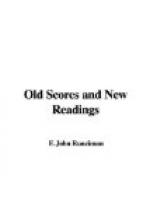It has that curious volubility and “mouthing”
quality that sometimes gets into Tschaikowsky’s
music; it is plausible and pretty; it suggests a writer
who either cannot or dare not use the true tremendous
word at the proper moment, and goes on delivering himself
of journalistic stock-phrases which he knows will move
those who would be left unmoved were the right word
spoken. There is nothing of this in the melody
of the second movement. Its ease is matched by
its poignancy: the very happy-go-lucky swing
of it adds to its poignancy; and the continuation—another
instance of the untamed Slav under the influence of
the most finished culture—has a wild beauty,
and at the same time communicates the emotion more
clearly than speech could. The mere fact that
it is written in five-four time counts for little—nothing
is easier than to write in five-four time when once
you have got the trick; the remarkable thing is the
skill and tact with which Tschaikowsky has used precisely
the best rhythm he could have chosen—a
free, often ambiguous, rhythm—to express
that particular shade of feeling. The next movement
is one of the most astounding ever conceived.
Beginning like an airy scherzo, presently a march
rhythm is introduced, and before one has realised the
state of affairs we are in the midst of a positive
tornado of passion. The first tunes then resume;
but again they are dismissed, and it becomes apparent
that the march theme is the real theme of the whole
movement—that all the others are intended
simply to lead up to it, or to form a frame in which
it is set. It comes in again and again with ever
greater and greater clamour, until it seems to overwhelm
one altogether. There is no real strength in
it—the effect is entirely the result of
nervous energy, of sheer hysteria; but as an expression
of an uncontrollable hysterical mood it stands alone
in music. It should be observed that even here
Tschaikowsky’s instinctive tendency to cover
the intensity of his mood with a pretence of carelessness
had led him to put this enormous outburst into a rhythm
that, otherwise used, would be irresistibly jolly.
The last movement, too, verges on the hysterical throughout.
It is full of the blackest melancholy and despondency,
with occasional relapses into a tranquillity even more
tragic; and the trombone passage near the end, introduced
by a startling stroke on the gong, inevitably reminds
one of the spirit of Mozart’s Requiem.
The whole of this paper might have been devoted to a discussion of the technical side of Tschaikowsky’s music, for the score of this symphony is one of the most interesting I know. It is full of astonishing points, of ingenious dodges used not for their own sake, but to produce, as here they nearly always do, particular effects; and throughout, the part-writing, the texture of the music, is most masterly and far beyond anything Tschaikowsky achieved before. For instance, the opening of the last movement has puzzled some good critics, for it is written in a




